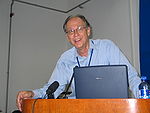- Michael Waterman
-
Michael Waterman 
Michael WatermanBorn June 28, 1942[1]
Coquille, OregonFields Computational Biology
Probability and Statistics
Computer Science
Discrete Mathematics and CombinatoricsInstitutions University of Southern California Alma mater Oregon State University
Michigan State UniversityKnown for Smith-Waterman algorithm
Lander-Waterman formula
Eulerian Sequence assemblyNotable awards American Academy of Arts and Sciences 1995,
Guggenheim Fellowship 1995,
United States National Academy of Sciences 2001,
Gairdner Foundation International Award 2002
French Académie des Sciences 2005
Honorary Doctorate, Tel Aviv University 2011Professor Michael S. Waterman is a scientist at the University of Southern California (USC),[2][3] where he holds an Endowed Associates Chair in Biological Sciences, Mathematics and Computer Science. He previously held positions at Los Alamos National Laboratory and Idaho State University. He grew up near Bandon, Oregon and earned a bachelor's degree in Mathematics from Oregon State University, followed by a doctorate in statistics and probability from Michigan State University in 1969.
Waterman is one of the founders and current leaders in the area of computational biology. He focuses on applying mathematics, statistics, and computer science techniques to various problems in molecular biology. His work has contributed to some of the most widely-used tools in the field. In particular, the Smith-Waterman algorithm (developed with Temple Smith) is the basis for many sequence comparison programs.[4] In 1988, Waterman and Eric Lander published a landmark paper describing a mathematical model for fingerprint mapping.[5] This work formed one of the theoretical cornerstones for many of the later DNA mapping and sequencing projects, especially the Human Genome Project.
With Sorin Istrail and Pavel A. Pevzner, he began the international conference Research in Computational Biology (RECOMB),[6] and he is a founding editor of Journal of Computational Biology. He is an elected Fellow of the American Academy of Art and Sciences since 1995, and was elected to the United States National Academy of Sciences in 2001. Since 2005, he is an elected Academician of the French Académie des Sciences. Waterman also authored one of the earliest textbooks in the field: Introduction to Computational Biology.[7]
References
- ^ American Men and Women of Science, Thomson Gale 2005
- ^ "Michael S. Waterman: Professor of Biological Sciences, Mathematics, Computer Science, University of Southern California". http://www.cmb.usc.edu/people/msw/Waterman.html. Retrieved 2011-07-21.
- ^ Maisel, M. (2006). "ISCB Honors Michael S. Waterman and Mathieu Blanchette". PLoS Computational Biology 2 (8): e105. Bibcode 2006PLSCB...2..105M. doi:10.1371/journal.pcbi.0020105. PMC 1526462. http://www.pubmedcentral.nih.gov/articlerender.fcgi?tool=pmcentrez&artid=1526462.
- ^ Smith, T.; Waterman, M. S. (1981). "Identification of common molecular subsequences". Journal of Molecular Biology 147 (1): 195–197. doi:10.1016/0022-2836(81)90087-5. PMID 7265238.
- ^ Lander, E. S.; Waterman, M. S. (1988). "Genomic mapping by fingerprinting random clones: A mathematical analysis". Genomics 2 (3): 231–239. doi:10.1016/0888-7543(88)90007-9. PMID 3294162.
- ^ "RECOMB". http://recomb.org/.
- ^ Waterman, Michael R.; Waterman, M. S. (1995). Introduction to computational biology: maps, sequences and genomes. London: Chapman & Hall. ISBN 0-412-99391-0.
External references
Categories:- American mathematicians
- Bioinformaticians
- American biologists
- American academics
- Members of the United States National Academy of Sciences
- University of Southern California faculty
- Living people
- Idaho State University faculty
- Oregon State University alumni
- People from Coos County, Oregon
- Fellows of Society for Industrial and Applied Mathematics
- Fellows of the International Society for Computational Biology
Wikimedia Foundation. 2010.
